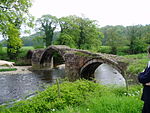All Hallows Church, Great Mitton
Church of England church buildings in LancashireChurches in Ribble ValleyDiocese of BlackburnEnglish Gothic architecture in LancashireEngvarB from April 2014 ... and 1 more
Grade I listed churches in Lancashire

All Hallows Church, Great Mitton, is in the village of Great Mitton, Lancashire, England. It is an active Anglican parish church in the deanery of Whalley, the archdeaconry of Blackburn, and the Diocese of Blackburn. Its benefice is united with that of St. John's Church, Hurst Green. The church is recorded in the National Heritage List for England as a designated Grade I listed building.
Excerpt from the Wikipedia article All Hallows Church, Great Mitton (License: CC BY-SA 3.0, Authors, Images).All Hallows Church, Great Mitton
Church Lane, Ribble Valley
Geographical coordinates (GPS) Address External links Nearby Places Show on map
Geographical coordinates (GPS)
| Latitude | Longitude |
|---|---|
| N 53.8461 ° | E -2.4339 ° |
Address
All Hallows Church
Church Lane
BB7 9PL Ribble Valley
England, United Kingdom
Open on Google Maps










